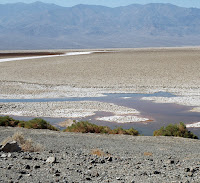 |
| Badwater Basin (www.nsf.gov) |
Recent discovery of a group of scientists at the University of Nevada Las Vegas (UNLV) is very surprising and profitable. They identified, isolated and grew a new type of magnetic bacteria that can lead to the use of new biotech and nanotech. Bacteria that they get from Badwater is located on the edge of Death Valley National Park.
Magnetotactic bacteria, the bacteria are simple and can be found almost every body of water. These bacteria can be oriented and navigate in a magnetic field. It happened because this bacterium produces a magnetic mineral or nano-sized greigiget (an iron sulfide mineral, the equivalent of the iron oxide magnetite). These crystal-krital called magnetosomes, and can be used for drug delivery and medical imaging.
The research have been conducted by scientists named Dennis Bazylinski (UNLV) and researcher named Christopher LeFevre (French National Center of Scientific Research and the University of Aix-Marseille II). They have published their research in the journal Science (http://dx.doi.org/10.1126/science.1212596). The research was funded by the U.S. National Science Foundation (NSF), the U.S. Department of Energy and the French Foundation for Medical Research.
"The finding is significant in showing that this bacterium has specific genes to synthesize magnetite and greigite, and that the proportion of these magnetosomes varies with the chemistry of the environment," said Enriqueta Barrera, program director in NSF's Division of Earth Sciences.
"Because greigite-producing bacteria have never been isolated, the crystals haven't been tested for the types of biomedical and other applications that currently use magnetite," said Bazylinski.
"Greigite is an iron sulfide that may be superior to magnetite in some applications due to its slightly different physical and magnetic properties. Now we have the opportunity to find out."
Researchers found the greigite-producing bacterium, called BW-1, in water samples collected more than 280 feet below sea level in Badwater Basin. Lefèvre and Bazylinski later isolated and grew it leading to the discovery that BW-1 produces both greigite and magnetite.
A detailed look at its DNA revealed that BW-1 has two sets of magnetosome genes, unlike other such bacteria, which produce only one mineral and have only one set of magnetosome genes.
This suggests that the production of magnetite and greigite in BW-1 is likely controlled by separate sets of genes. That could be important in the mass production of either mineral for specific applications.
According to Bazylinski, the greigite-producing bacteria represent a new, previously unrecognized group of sulfate-reducing bacteria that "breathe" the compound sulfate rather than oxygen as most living organisms do.
"With how much is known about sulfate-reducing bacteria, it's surprising that no one has described this group," he said.
Source: http://www.nsf.gov/news/news_summ.jsp?cntn_id=122618&org=NSF&from=news
Post a Comment